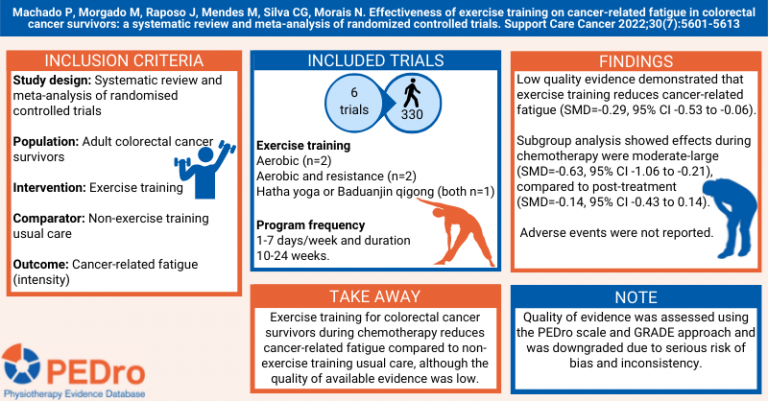Exercise for colon cancer survivors is not just a path to physical fitness; it plays a crucial role in enhancing long-term survival and quality of life. Recent studies reveal that regular physical activity after cancer treatment can significantly narrow the survival disparity between colon cancer patients and the general population. As colon cancer remains a leading cause of cancer-related deaths, integrating exercise into recovery plans is imperative for boosting survival rates among these individuals. Engaging in consistent exercise not only contributes to a healthier lifestyle for colon cancer survivors but also supports improved cancer survival statistics. By committing to a regimen of physical activity, cancer patients can harness the profound benefits of exercise, which may help elevate their overall well-being and longevity post-treatment.
For individuals recovering from colorectal carcinoma, engaging in physical rehabilitation is vital for fostering resilience and extending life expectancy after treatment. Activities promoting fitness for survivors of bowel cancer are shown to enhance overall health and diminish the odds of recurrence. By adopting an active lifestyle, cancer survivors can bridge the gap between their recovery and normal health metrics, enhancing their well-being. The evidence supporting the positive linkage between exercise and improved outcomes in cancer recovery underscores the importance of incorporating movement into daily routines. Ultimately, pursuing an energetic lifestyle post-cancer not only facilitates physical recovery but also uplifts the spirit of colorectal cancer survivors.
Understanding the Importance of Physical Activity for Colon Cancer Survivors
Physical activity is more than just an exercise regimen; it’s a pivotal component for colon cancer survivors striving to enhance their quality of life and longevity. Recent studies indicate that regular physical activity following treatment, particularly for those diagnosed with stage 3 colon cancer, can significantly close the survival gap between these patients and the general population. By engaging in even moderate exercise, survivors can reap various benefits, including reducing the risk of recurrence and improving overall well-being.
Moreover, survival rates demonstrate a direct correlation with levels of activity. Research shows that survivors who maintain high activity levels not only enjoy a better quality of life but also exhibit improved survival statistics when compared to less active individuals. For those seeking to embrace a healthy lifestyle after colon cancer treatment, incorporating physical activities can lead to a more resilient body and mind.
Exercise for Colon Cancer Survivors: A Path to Longevity
The evidence is clear: exercise for colon cancer survivors is essential. Patients who engage in regular physical activity post-treatment have been shown to have survival rates that are comparable to their healthy counterparts. This indicates that a commitment to physical fitness can significantly alter the trajectory of a survivor’s cancer journey. Simple activities such as walking, cycling, or yoga can contribute to substantial improvements in health.
In particular, those who manage to achieve 18 or more metabolic hours of activity weekly have reported survival rates remarkably closer to the general population. This highlights the importance of creating personalized exercise plans that cater to individual capabilities while promoting consistent engagement in physical activity.
Navigating Life After Colon Cancer: The Role of a Healthy Lifestyle
Transitioning back to everyday life after a colon cancer diagnosis can be daunting. However, embracing a healthy lifestyle — which includes nutritious diets alongside regular exercise — is integral to improving post-treatment outcomes. The adoption of healthy habits can lead to stronger immune responses, better management of residual symptoms, and lowered chances of cancer recurrence.
Additionally, focusing on enhancing one’s overall health through lifestyle choices can foster a sense of community and support among survivors. Engaging in group exercise or participating in health-focused activities not only aids in physical recovery but also provides emotional and psychological benefits, creating a holistic recovery experience.
Cancer Survival Statistics and the Impact of Increased Activity Levels
Understanding cancer survival statistics is crucial for both patients and healthcare providers. The findings from clinical trials reveal that those who engage in higher levels of physical activity after colon cancer treatment have significantly improved odds of surviving compared to those who remain sedentary. A staggering 50.5% disadvantage in survival for low-activity patients emphasizes how crucial exercise is in a survivor’s journey.
It’s also noteworthy that even small increments in daily physical activity can lead to meaningful improvements. Patients are encouraged to consider that every little bit counts; whether it’s a short walk or mild stretching, these activities accumulate to foster better outcomes and enhance survivorship.
The Physiological Benefits of Regular Exercise for Cancer Patients
Regular physical activity offers numerous physiological benefits for colon cancer survivors. Exercise helps to regulate body weight, improves cardiovascular health, and enhances muscle strength and endurance. These factors are particularly important for cancer survivors, as they can mitigate treatment-related fatigue and strengthen the body’s ability to combat illness.
Additionally, exercise has been associated with reduced inflammation and improved immune function, both of which are beneficial for those recovering from cancer. Engaging in consistent physical activity can directly influence the body’s ability to heal and function efficiently, ultimately contributing to improved survival rates for colon cancer survivors.
Breaking Down Barriers: Overcoming Challenges to Staying Active After Cancer
Numerous survivors face challenges that can inhibit their ability to stay active post-treatment. Whether due to physical limitations, fear of recurrence, or psychological barriers like anxiety and depression, these obstacles can create a significant gap in engaging in physical activities. However, understanding and addressing these challenges through community support and professional guidance is essential.
Physical therapy and tailored rehabilitation programs play a crucial role in equipping cancer survivors with the tools to reclaim their active lifestyles. By fostering a mindset of resilience and seeking appropriate support, survivors can overcome barriers and embrace an active, fulfilling post-cancer life.
Incorporating Exercise into Daily Routines: Practical Tips for Survivors
Incorporating regular exercise into daily routines can be a game-changer for colon cancer survivors. Starting with small, manageable goals can help ease individuals back into a physically active lifestyle. For instance, adding a daily walk, participating in community fitness classes, or engaging in light stretching sessions can be beneficial. Over time, these small actions can lead to significant increases in activity levels.
Moreover, scheduling exercise like any other appointment can promote consistency. Whether it’s setting aside time for a daily walk or joining friends for a weekly workout class, establishing a routine can help solidify the habit of staying active and ensuring that one remains committed to a healthier lifestyle.
The Psychological Advantages of Staying Active Post-Cancer Treatment
Maintaining physical activity after cancer treatment offers profound psychological benefits for survivors. Regular exercise is known to enhance mood, reduce anxiety, and improve overall mental health. For many colon cancer survivors, engaging in physical activity serves as a vital outlet for coping with the emotional aftermath of their diagnosis and treatment.
Exercise can also foster a sense of control and empowerment, allowing survivors to reclaim their lives post-cancer. The act of dedicating time to one’s health can instill a positive outlook, thereby promoting a more optimistic mindset towards recovery and future wellness.
Creating a Supportive Environment for Exercise Among Cancer Survivors
A supportive environment plays an essential role in encouraging colon cancer survivors to adopt an active lifestyle. Whether it’s through community programs, support groups, or partnerships with healthcare professionals, having a network can motivate survivors to stay active. An environment that promotes physical activity can significantly impact their recovery journey, fostering connections with peers who share similar experiences.
Furthermore, creating accessibility to exercise facilities and programs tailored specifically for cancer survivors is crucial. Engaging with professionals who understand the unique challenges faced by these individuals can facilitate smoother transitions into regular physical activity, enhancing both physical and emotional aspects of recovery.
Frequently Asked Questions
What role does exercise play in improving survival rates for colon cancer survivors?
Regular exercise after treatment for colon cancer significantly improves survival rates. According to research, colon cancer survivors who engage in high levels of physical activity show survival rates closer to those of the general population. This suggests that incorporating exercise into a healthy lifestyle after cancer can lead to better long-term outcomes.
How can cancer survivors incorporate physical activity into their daily routine?
Colon cancer survivors can start by integrating simple physical activities into their daily lives, such as walking, swimming, or yoga. Even small amounts of exercise, like 10 to 20 minutes a day, can provide significant benefits. Aim for at least 18 MET-hours of activity per week for optimal effects on health and survival.
What are the exercise benefits for cancer patients post-treatment?
Exercise provides numerous benefits for cancer patients post-treatment, including improved physical health, enhanced emotional well-being, and better overall quality of life. Research indicates that engaging in regular physical activity helps reduce the risk of cancer recurrence and improves survival rates among colon cancer survivors.
What types of exercise are recommended for colon cancer survivors?
Colon cancer survivors can benefit from a variety of exercises, including aerobic activities like walking and cycling, strength training, and flexibility exercises like stretching and yoga. A well-rounded fitness program tailored to individual capabilities can enhance recovery and promote a healthy lifestyle after cancer treatment.
What survival statistics exist for colon cancer survivors who engage in exercise?
Studies show that colon cancer survivors with high physical activity levels have survival rates significantly closer to those of matched controls. For example, high activity levels were associated with a mere 3.5% reduction in survival rates compared to the general population, whereas low activity levels resulted in survival rates 17.1% lower.
How much exercise should colon cancer survivors aim for weekly?
Colon cancer survivors are encouraged to aim for at least 18 MET-hours of physical activity per week, which translates to about an hour of moderate exercise most days. However, any amount of exercise is better than none, so starting small can still lead to substantial health benefits.
Can low levels of physical activity affect colon cancer survival rates?
Yes, low levels of physical activity after colon cancer treatment are linked to significantly reduced survival rates. Research indicates that survivors with low activity levels faced a 50.5% lower survival rate compared to those with higher activity levels, underscoring the importance of integrating exercise into recovery and health maintenance.
What should colon cancer survivors know about starting an exercise regimen?
Colon cancer survivors should consult with their healthcare provider before starting any exercise regimen. It’s important to choose activities they enjoy, start gently, and gradually increase intensity and duration. Regular physical activity not only aids recovery but also fosters a healthier lifestyle overall.
| Key Point | Details |
|---|---|
| Exercise Improves Survival Rates | Regular physical activity post-treatment significantly reduces survival disparities between colon cancer survivors and the general population. |
| Impact of Activity Level | Survivors with high activity (18+ MET-hours/week) had survival rates closer to the general population compared to those with low activity ( |
| Study Source | The findings are based on data from National Cancer Institute trials CALGB 89803 and CALGB 80702 involving 2,875 patients. |
| Recommendation | Engaging in even minimal exercise (10-20 minutes) can lead to improved health outcomes for survivors. |
| Importance of Regular Exercise | Exercise benefits all patients regardless of age, contributing to better survival rates and lessening disparities in recurrence outcomes. |
Summary
Exercise for colon cancer survivors is crucial for enhancing their quality of life and longevity. Engaging in regular physical activity post-treatment not only improves survival rates but can also bridge the gap between cancer survivors and individuals in the general population. Research indicates that high activity levels significantly increase the chances of long-term survival, emphasizing the importance of incorporating even short bouts of exercise into daily routines. This makes exercise a vital component of recovery and overall health management for colon cancer survivors.









